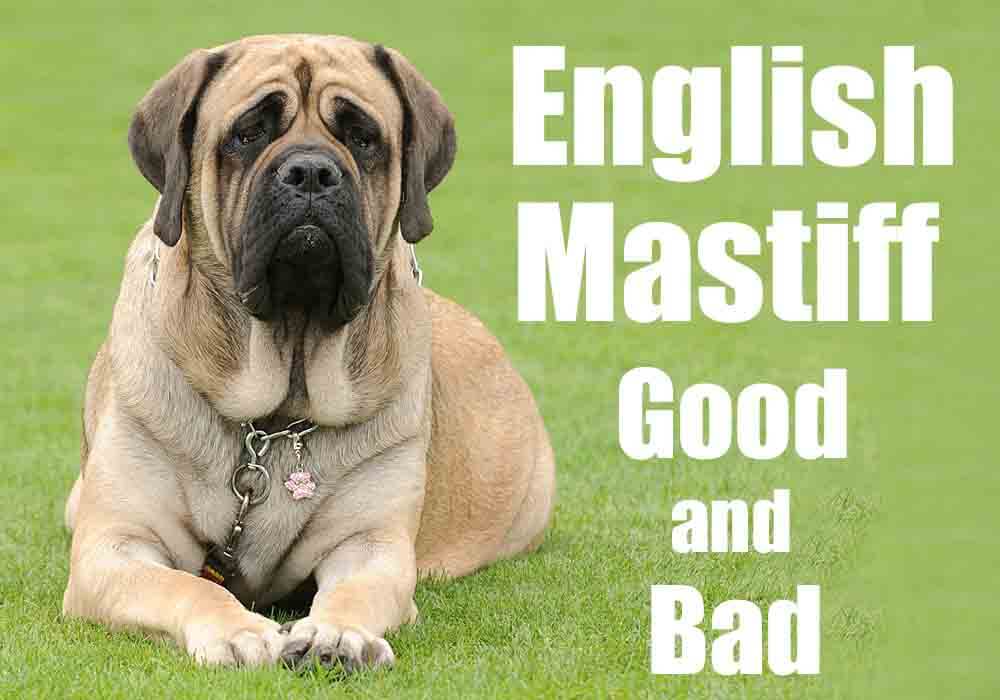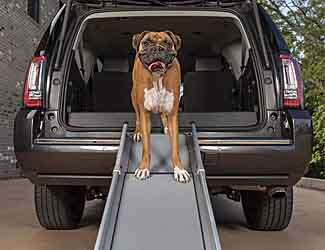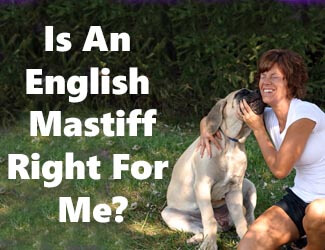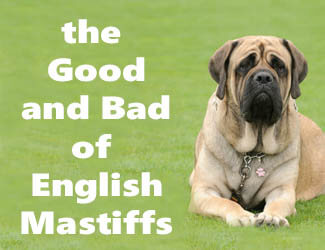English Mastiff Dog Breed Information
History, Traits, Temperament
by Ken Alden
The English Mastiff (also known as the
Old English Mastiff, or simply the Mastiff) is one of the largest breeds of
dogs and is frequently referred to as a gentle giant. With a large, symmetrical head and signature
black mask and well-knit, muscular body, this dog’s outwardly fearsome
appearance belies its loving and fiercely loyal nature.
If you are considering owning one or simply want to learn more about this magnificent canine, this article will thoroughly examine this beloved dog breed, starting with its ancient origin and history, providing an in-depth discussion of this breeds unique traits and characteristics, and discussing this dog’s personality and temperament.
This is a breed often
associated with the British nobility and has a rich, decorated history. As we will see, this dog has
a humble origin with a strong working dog heritage that is attributable to its
massive size, unmatched strength and instinctual devotion to its human
family. Read More Below...
Pro-tip: Ever try lifting an English Mastiff? Their weight can hurt not only your back but their joints when they hop down from cars, sofas or even your bed. To protect your back and theirs check out the best Mastiff ramps on Amazon.com now.

English Mastiff History
Dog historians and scholars disagree on the specific evolution and lineage of today’s English Mastiff. What is certain is that this dog is descended from truly hearty and fearless stock, and while this dog’s physical features may actually be leaner and slighter than in centuries past, the breed remains one of the most physically imposing dogs around.
Dogs with Mastiff-like attributes
frequently appear in ancient drawings, carvings, and even sculptures. They are depicted with short muzzles, large
square heads with the signature droopy ears, thick and well-defined musculature
and overall solid build with a heavy-boned structure. Some of these depictions date back to 2,500
BCE or even older.
Breed Origin
It is widely believed that today’s variation descends from the Molosser (or Molossus), which may have originated in the mountainous regions of Tibet or Northern India in Asia. As the Molossers of the ancient world accompanied their owners on trade routes and military campaigns throughout the regions known today as the Middle East, the Mediterranean and eventually Europe, the breed began to spread.
One popular account from the ancient world describes how Julius Caesar was so impressed by the unflinching loyalty and courage of the Mastiff dogs he encountered in Britain during the Roman invasion in 55 BCE that he brought them back to Rome with him. These transplanted Mastiffs were immediately deployed to guard palaces and estates and to protect livestock from predators.
Sadly, the ferocity and brute strength
of the newly Romanized Mastiffs were also entertainment fodder for ancient
Romans as they were thrown into arenas throughout the Roman Empire to battle
wild animals and even human gladiators
Evolution of the English Mastiff
The modern version is directly descended from the breed that was developed during England’s medieval period, sometime during the 13th or 14th centuries. These dogs were bred primarily to guard the estates of noble classes, participate in big game hunting, and to protect herds of sheep and the like. Medieval era Mastiffs were even trained to fight alongside soldiers during times of war.
During medieval times Mastiffs were
subjected to practices that would be inhumane and cruel by today’s standards,
such as dog fighting and bull-baiting (pitting a Mastiff against a restrained
bull). As a result, the temperament of
the breed during the Middle Ages in Britain was markedly more ferocious and
aggressive compared to the more docile English Mastiffs of the modern era.
A Key Turning Point in English Mastiff History
The 19th century marked a significant turning point in the history and development of this breed as it was during this time that brutal treatment of the breed was finally outlawed. Several outstanding lines of Mastiffs were established, including the renowned Lyme Hall line, which continued well into the 20th century.
Legend has it that Sir Piers Legh of
Lyme Hall, Cheshire, fought in the Battle of Agincourt in France and was seriously
injured in battle. His Mastiff dutifully
guarded over him until help arrived, and only when he was lifted away from the
battlefield did the courageous canine leave her master’s side.
Near Extinction in the 1900s
Due to their enormous size and stature, English Mastiffs have very large appetites, and this nearly led to this breed’s demise during the 1900s. Food shortages during World War I and World War II in war-torn Britain decimated the Mastiff population and it is said that by the end of the Second World War there remained less than 20 of the breed in all of Britain.
The English Mastiff stock was slowly
re-populated and revived with the help of Mastiffs from good British lineage
that were sent back to Britain from the U.S. and Canada. This breed has reclaimed its title
as one of Britain’s most beloved dog breeds.
English Mastiffs’ Arrival in America
It is said that there were two dogs aboard the Mayflower when it crossed the Atlantic and landed at Plymouth, and one of them was an English Mastiff (the other was a spaniel). Whether or not the breed first arrived with the original Pilgrim settlers, it is well established that this dog has a long history in the United States.
In
1885 the American Kennel Club formally recognized the breed along with 14
others and classified this dog in the Working Group to designate it
as a dog that was originally bred for a purpose related to tasks or duties
other than herding and hunting (e.g., guarding and defending). This classification also distinguished the
English Mastiff from dogs bred for appearance or exclusively as pets.
The American Kennel Club’s Dog Breed Classifications
1) Hound Group
2) Terrier Group
3) Working Group
4) Herding Group
5) Sporting Group
6) Non-Sporting Group
7) Toy Group
8) Miscellaneous Group/Class
Pro-tip: English Mastiff anxiety, aggression, destructive chewing, jumping up, fearfulness, and other behaviors can be controlled with the right training program.
Here’s a great course that
addresses these issues along with many other dog training basics: Check it out now!
English Mastiffs Today
This breed is very well
established in Britain, Canada, and the United States. According to the American Kennel Club, this
breed was the 29th most popular dog in America in 2018 (out of 192 breeds). In the five preceding years, Mastiffs ranked
28th, 28th, 25th, 26th and 26th
consistently ranking as one of America’s thirty most popular dogs.
English Mastiff Traits
This dog is considered the
largest dog breed, particularly when classifying by weight. In 1987 an English Mastiff named Zorba
weighed in at 343 pounds (he also measured 8 feet 3 inches from his nose to the
tip of his tail).
Size (Height & Weight)
The males of this breed can measure 30
inches and up at the shoulder (also referred to as the “withers,” where the
neck and shoulders meet) and typically weigh between 160 to 230 pounds. Larger males will often outweigh their
owners. Females are
smaller and lighter, measuring 27.5 inches and up and weighing 120 to 170
pounds.
Appearance
This breed is distinguishable by their heavy-set, thick-boned build with proportionate, rectangular, and well-knit bodies. They have thick necks that increase in breadth toward their shoulders. Both the forequarters and hindquarters are powerful and muscular with matching angulation at the joints. Their paws are large and round, with arching toes and black nails. They have tapering tails that are set high.
Their heads are massive and
square-shaped with v-shaped ears that droop over each side. One of the signature attributes of this breed
is the distinct black mask that encompasses their short muzzle and facial
area. Their foreheads are heavily
wrinkled, adding to their kind, gentle facial expression that belies their
gargantuan size.
Coat and Color
This breed has a double coat consisting of a coarse and straight overcoat and a dense and short undercoat that lays flat and close to the skin. This breed is considered average shedders, meaning they actively shed about twice per year (typically in the spring and fall). Regular brushing will help manage their rate of shedding.
English Mastiffs have coats of the following colors:
- Fawn – a light yellowish tan color (more tan than yellow).
- Apricot – a light yellowish-orangish color, somewhat lighter than the dried fruit it is named after.
- Brindle – subtle tiger-like striping that consists of irregular streaks that are much darker than the base fawn or apricot coat.
Some dogs have a small patch of white
on their chests. However, the American
Kennel Club considers excessive white on the coat, particularly areas other
than the chest, to be a fault under breed standards (primarily for dog show
purposes).
Gait and Posture
This dog has a naturally
athletic stance when standing still or at attention. Its legs are set fairly wide apart, giving
this dog the appearance of being ready to spring into action at a moment’s
notice. When walking or trotting this dog’s natural leg motion is straight forward and tracks smoothly
with a strong, powerful gait.
Life Span
As is typical of large dogs, this breed has a shorter life span than smaller breeds. The average life span or expectancy is 6 to
10 years although it is not uncommon for a particularly well-bred and cared-for
dog to live 12 or 13 years.
Litters
As you would expect from a dog this
size, they produce enormous litters consisting of 10 to 12
puppies. One particular Mastiff in
England gave birth to an incredible 24 puppies in 2004, 20 of which survived
the first week. The typical gestation
period of this breed is about 64 days in length.
English Mastiff Temperament
When one refers to a dog’s temperament, typically it means how the dog reacts or responds to certain stimuli, namely other dogs and people (particularly strangers). A dog’s temperament is shaped and determined by a combination of inherited (genetic) and environmental (such as training, upbringing and treatment) factors.
Personality
In the case of the English Mastiff, this breed’s temperament is heavily influenced by the dog’s breeding, upbringing, level of nurturing, and degree of care. Despite their imposing physical presence, this is a highly sensitive and gentle breed and their temperament, particularly around people, is reflective of their social upbringing and training.
This breed has an instinctual wariness of strangers, which undoubtedly made them natural-born guard dogs throughout their history. With proper training from a puppy stage, an English Mastiff can be acclimated to different people and maintain their calm demeanor even in the presence of strangers. Socialization is a critical component of training this breed.
It is in their nature for this breed to be protective of their human family members, and they will often follow them from room to room to ensure their well-being. While not overly affectionate and attention-seeking this breed is at its best when in the presence of a firm but loving human presence.
Intelligence
The English Mastiff is considered an intelligent dog and takes training well provided that it is done in a firm but nurturing manner. They are naturally protective of those with whom they form a social or family bond, and when shown which persons are to be trusted, can quickly and ably discern between a friend and a threat.
This breed is renowned for having a “soft mouth,” the innate ability to carry delicate things between their massive, powerful jaws and deliver them perfectly unscathed (albeit with plenty of slobbering). Along the same vein, this breed is instinctually gentle with babies and children, although caution should be exercised simply due to their sheer size and mass.
It is also worth noting that English Mastiffs seek to please their owners and are therefore highly responsive to positive reinforcement, encouragement, and small rewards. They also have great memories so they will retain as adults what they learned and were taught when they were puppies which is why training at the earliest possible age is critical to their overall development.
Pro-tip: English Mastiff's (and their owners) love dog crates…and for good reasons. Crates keep dogs from mischief while you're away, are perfect for house training, for traveling by car, and provide the dog a place to de-stress. Check out the best Mastiff crates on Amazon.com now.
Behavior
English Mastiffs are shy and highly protective by nature, and these instincts need to be subdued or suppressed by training from an early age. Perhaps the most critical aspect of puppy training is socializing the dog to other animals and people; otherwise, through no fault of its own, this dog may develop aggression and will not know how to interact with people and animals they encounter.
Partly attributable to its intelligence, this dog can be quite stubborn at times, particularly during the teen or adolescent period which typically runs from nine months to two years of age, and they will test boundaries and push limits. And, they will remember the outcomes. To put it best, this dog is more selectively hard of hearing than they are disobedient.
The modern breed is far removed from the fearsome and aggressive Mastiffs of medieval and ancient times. It is in their nature to shy away from confrontation unless the dog senses that a loved one is being threatened. Furthermore, many English Mastiffs display their inner temperament even as puppies; a playful, curious pup will continue that behavior as an adult with proper and timely training.
Learn even more about the English Mastiff temperament here...
English Mastiffs Dislike Conflict
Unlike
their predecessors from centuries ago, today’s English Mastiffs are
highly sensitive animals that react to perceived conflicts. They have
been known to step in between arguing spouses and intercede between a
parent disciplining a child. When mistreated, either verbally or
physically, they can become shy, fearful, or aggressive.
Other Common Attributes And Characteristics of English Mastiffs
Although, as with any other breed,
each individual dog will have its own personality and unique traits and quirks,
there are certain attributes and characteristics that are shared by many
English Mastiffs. Here is a sampling of
a few interesting ones:
- By nature they are heavy droolers;
- Flatulence and gassiness are common among dogs of this breed, although this condition can be somewhat curtailed through a strictly monitored diet;
- Despite descending from a long lineage of rugged, hardworking animals, today’s English Mastiffs have a lazy streak and need daily activity to avoid obesity;
- Without daily stimuli and exercise, this dog is prone to boredom and may become destructive;
- Because of their enormous size and heavy bone structure, young dogs should not be overly exercised in order to ensure proper growth and development of their tender bones and joints;
- Pups and adolescents are very clumsy and lack coordination;
- They can be voracious diggers if left unattended outdoors for prolonged periods;
- While English
Mastiffs seldomly bark or growl, they do snore and grunt, sometimes quite
loudly.
English Mastiff Health Concerns
Just like people, dogs can be at
higher risk of developing genetic or hereditary health problems, and certain
breeds can be more prone to specific ailments and diseases due to their unique
attributes. If you have or plan to raise
an English Mastiff, it would be prudent to be aware of these potential health
conditions.
Structural Health Problems
It would come as no surprise that because of their massive size and sheer mass, this dog suffers from a variety of joint and structural maladies. Some are genetic, while others can develop with age as the result of overly strenuous activity at a premature age, obesity, or injury. Here are a few common afflictions relating to body structure:
- Hip Dysplasia
- Elbow Dysplasia
- Cranial Cruciate Ligament Problems
Bloat and Gastric Torsion
These are potentially life-threatening
conditions that affect this dog more than other dog breeds, primarily
due to their large chests and abdominal cavities. Bloat occurs when the dog’s stomach distends
with gas or air, usually as the result of eating or drinking too fast,
exercising strenuously immediately after a meal, or eating excessive amounts in
a single meal.
Eye Problems
They are susceptible to various eye ailments, including deformities in their eyelids, formation of lesions on their eyeballs and the more serious condition, progressive retinal atrophy (PRA) which is a hereditary disorder that gradually leads to complete blindness in the affected eye.
Heart Problems
Their massive size makes this dog more prone to heart conditions than other breeds, and dog obesity heightens these risks.
Regular cardiac exams should be part of their long term care regimen, and above all else, maintaining a proper diet with proper eating habits is invaluable to good cardiac health.
Cancer
There are many forms of cancer that
can affect dogs. Bone cancer
(osteosarcoma) is one form that affects this dog more than other breeds
and in advanced cases, can result in amputation of the affected limb followed
by chemotherapy.
The Importance of Finding a Reputable Breeder
All the genetic testing and screening in the world cannot guarantee that a puppy will go on to live a life free from disease or health conditions.
However, because so many conditions afflicting this breed are hereditary or genetic and scientific advancements make it possible to accurately determine risk factors, regular screening, and testing is important not only to your dog’s health but in a broader sense, to maintaining the overall health of the entire breed for generations to come.
If you have decided to bring an English Mastiff into your home, the first step will be to find a reputable breeder. This means much more than just good reviews found online. A responsible dog breeder will be above all else, completely forthcoming about not only the puppy’s condition but more importantly, the health histories and clearances of both parents.
Health Clearances
A reputable English Mastiff breeder will provide the following information with proper documentation pertaining to a puppy and its parents:
- Hip Evaluation
- Elbow Evaluation
- Ophthalmologist Evaluation
- Cardiac Exam
To aid prospective English Mastiff and other dog breed owners, the Canine Health Information Center (CHIC) maintains an extensive database of health clearances and test results and assigns a unique CHIC number to each individual dog for which proper OFA and CERF documentation has been received. Optional documentation accepted by CHIC includes thyroid and cystinuria testing.
Owning a dog is a responsibility not
to be taken lightly, particularly in the case of English Mastiffs. The commitment to providing firm but loving
structure begins from the moment they are first brought into the home but will
be repaid tenfold by their loyalty, compassion, and devoted companionship.
Return to the top of this English Mastiff page

About the Author...
Ken Alden, a dedicated Mastiff owner for over eight years, is acclaimed for his expertise in care, grooming, and training. Read more About Me and my dog Shadow.
- Mastiff Guide Home ›
- English Mastiffs ›
- English Mastiff Information









